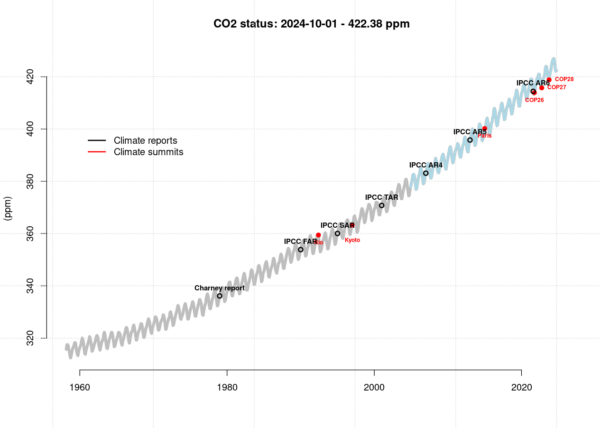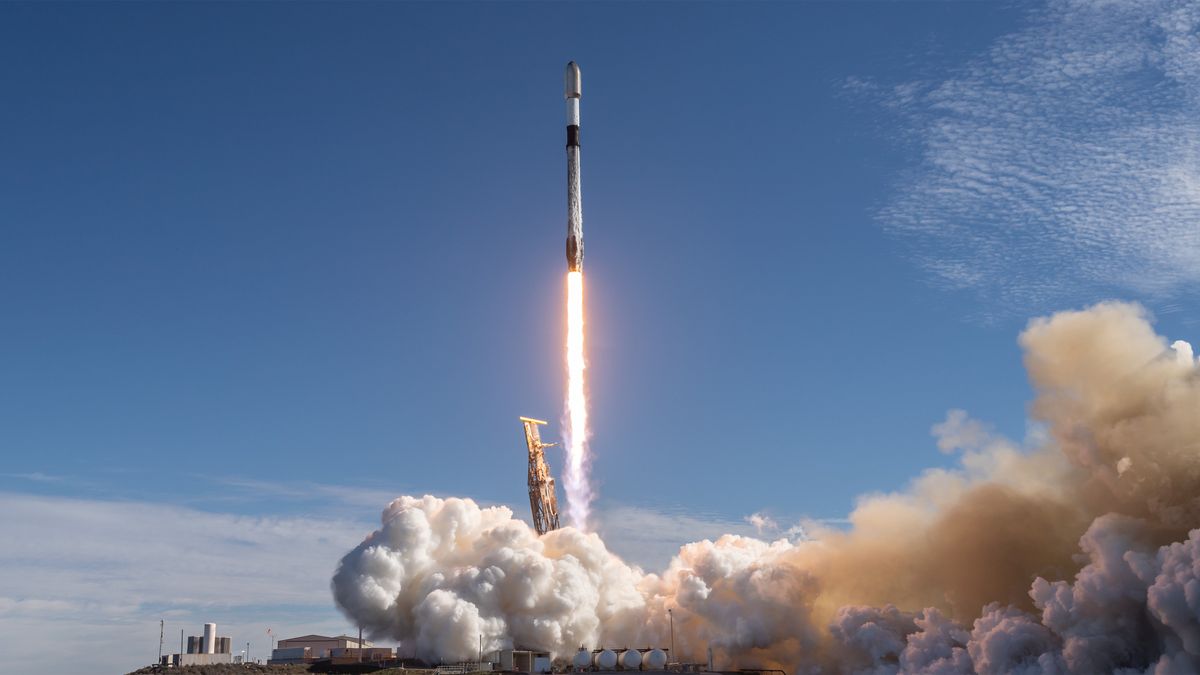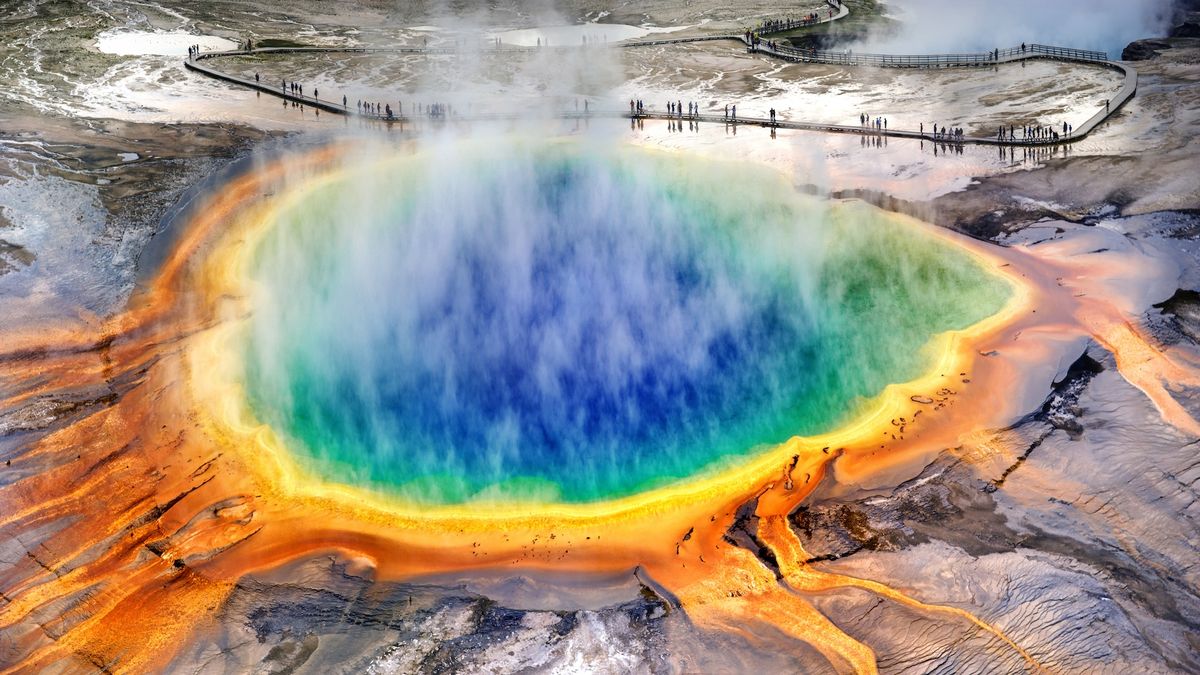It’s 20 years since we started blogging on climate here on RealClimate (December 10, 2004). We wanted to counter disinformation about climate change that was spreading through various campaigns. In those days it was an unusual move that prompted a welcome from Nature.
One thing that I didn’t anticipate then was the vast global scale that fake news and conspiracy theories later would attain. Neither did I foresee how they would penetrate other disciplines, nor the extent of the division in today’s society between those who value truths and those who don’t.
There is one graph that perhaps tells the story of what has happened since 2004, and it’s the Keeling curve shown in the figure below. It shows the atmospheric concentrations of carbon dioxide (CO2) and tells a story about the carbon cycle, involving Earth’s crust, the atmosphere, land surface, the biosphere, and the oceans.

The CO2 levels have increased at an increasing pace in the atmosphere as well as in the oceans, and the sad irony is that the rate of growth has increased after every climate summit (Conference of the Parties, also known as COP) and assessment report from the Intergovernmental Panel on Climate Change (IPCC).
Similarly, there have been increases in other greenhouse gases, which Gavin nicely describes in his recent post Operationalizing Climate Science. In a nutshell, they are responsible for climate change, mainly due to an increased greenhouse effect. The consequence is global warming, changes to Earth’s hydrological cycle, melting ice and snow, thawing permafrost, rising sea levels and changes to the weather statistics.
This year is on track to be the warmest ever observed according to the WMO and data provided by the European Copernicus Climate Services (C3S). Our society has not been adapted to these changes, and the situation is far from stabilised.
So what has gone wrong? A recent editorial from the Guardian discusses some flaws and weaknesses of past COPs and a similar sentiment has been reported in the Washington Post.
On the one hand, there are people who have learned from the impressive efforts that have been dedicated to explaining climate change and to increasing climate literacy. One example is this video produced for the National Academy of Sciences, Engineering and Medicine (NAS).
An enhanced understanding of climate change has been a force behind the growth in solar panels, wind power, and electric cars. There has also been technical progress unrelated to climate change, such as Artificial Intelligence (AI), and we can now use chatGPT to respond to emails from climate deniers which was science fiction in 2004. AI is also currently revolutionising weather forecasting.
And there is a growing awareness concerning links between nature, biodiversity and climate, but we still struggle getting our main message through to everyone.
It strikes me that we still have a bad habit of speaking in a code language with confusing phrases and terminology that is only familiar for those already familiar with climate science and who already are persuaded. I wrote a post on the IPCC’s summary for policymakers (SPM) on this in 2023, but without much effect. Today there exist AI tools that can translate a scientist’s Powerpoint presentation into something that is more pedagogic and understandable for a lay person, so maybe this situation will improve.
There also seems to have been little dialogue across different sectors and disciplines and a lack of trust. Obviously, the message from climate scientists has not reached those decision-makers who could bend the Keeling curve downwards. In other words, our knowledge about climate change has not reached those leaders who may have the greatest effect on dealing with the production of coal, oil and gas. The message needs to be understood in the boardrooms of oil and coal companies, and by their CEOs, shareholders, and investors. Also by OPEC and politicians who make decisions about fossil resources.
Another thing I didn’t anticipate in 2004 was efforts such as the World Weather Attribution (WWA). Attribution connects weather and climate and may remind decision-makers within the fossil sector about the fact that we share the same planet and that global warming will affect everyone, either directly or indirectly. In a recent paper (Benestad et al, 2024) we provide an even clearer picture than before of extreme temperature and precipitation having become more frequent and widespread since 1950. Such extremes have a devastating impact on both nature and society.
Finally, in 2004 I didn’t anticipate that social media, such as Twitter (now X) and Facebook, would dominate the spread of both information and disinformation. Blogs ended up in the shade of social media for years, but things are changing, spurred by scandals surrounding Facebook and X. Newspapers such as the Guardian no longer posts on X, and I’m giving BlueSky a go like many of my good colleagues. Hopefully, increased activity on BlueSky may steal some of the juice from X.
References
- R.E. Benestad, C. Lussana, and A. Dobler, “Global record-breaking recurrence rates indicate more widespread and intense surface air temperature and precipitation extremes”, Science Advances, vol. 10, 2024. http://dx.doi.org/10.1126/sciadv.ado3712
The post Twenty years of blogging in hindsight first appeared on RealClimate.









Leave a Comment